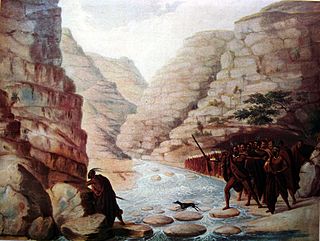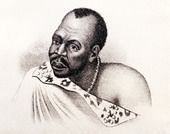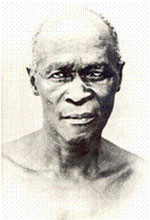The following lists events that happened during 1835 in South Africa.

The Xhosa Wars were a series of nine wars or flare-ups between the Xhosa Kingdom and encroaching European settlers in what is now the Eastern Cape in South Africa. These events were the longest-running military action in the history of European colonialism in Africa.

Butterworth is a town in the Eastern Cape Province, South Africa. Butterworth has a population of 45,900 and is situated on the N2 national highway 111 km north of East London.

Hintsa ka Khawuta, also known as Great or King Hintsa, was the 13th king of the amaXhosa nation from his great ancestor, King Xhosa. He ruled from 1820 until his death in 1835. His main territory stretched from Mbhashe River, south of Mthatha to the Gamtoos River, in the Southern Cape. Hintsa led the most powerful kingdom (AmaXhosa) in the Cape Province, which fought against white colonial expansion in Southern Africa for a period of 100 years over the generations.
Nqoko ka Gcaleka was a regent and 3rd king of the Xhosa nation.

Sarili ka Hintsa was the King of Xhosa nation from 1835 until his death in 1892 at Sholora, Bomvanaland. He was also known as "Kreli", and led the Xhosa armies in a series of frontier wars.

Sigcawu ka Sarili was the King of the Xhosa nation from 1892 until his death in 1902. His father was Sarili ka Hintsa and mother Queen Nobuthe.
Bhurhu ka Khawuta (1785–1857) was the elder brother of King Hintsa and Malashe. As Hintsa was born by Khawuta's Great wife Hintsa succeeded Khawuta. Bhurhu was very active in the wars in which Hintsa led the Xhosa nation, as he was the sub chief of the Gcaleka. He played a huge role in Hintsa's leadership. Bhurhu died in 1857 and his resting place is in Ngqamakwe, he succeeded as a sub chief by Mapasa, who led along the area known as Tutura and beyond.
The Gcaleka House is the senior house of the Xhosa Kingdom in what is now the Eastern Cape. Its royal palace is in the former Transkei and its counterpart in the former Ciskei is the Rharhabe, which is the second senior house.
Ityala Lamawele is the first extant novel in the Xhosa language. It was written by Samuel Edward Krune Mqhayi (1875–1945) and published in 1914, by the Lovedale Press. Since that time it has been a significant influence on isiXhosa literature.

Centane is a settlement in Amathole District Municipality in the Eastern Cape province of South Africa. It is situated at approximately 31 kilometres (19 mi) from Butterworth.

Thembuland, Afrikaans: Temboeland, is a natural region in the Eastern Cape province of South Africa. Its territory is the traditional region of the abaThembu, one of the sub-groups of the Xhosa nation.

Maqoma (1798–1873) was a Xhosa chief and a commander of the Xhosa forces during the Cape Frontier Wars. Amongst the greatest of Xhosa military commanders, he played a major part in the Sixth and Eighth Xhosa Wars. He is remembered as one of the greatest warriors from Southern Africa, as he inflicted a couple of defeats on the British troops, known for his use of traditional weapons such as shield and assegai or spear.
The AmaNdlambe are a tribe located in the Eastern Cape, South Africa; having been so named after its originator the Xhosa prince Ndlambe, son of King Rharhabe. The AmaNdlambe are one of the last tribes to have been created in Xhosa history around the turn of the 19th century.
Mbombini Molteno ka Sihele was a Xhosa Councillor and warrior, as well as the national poet ("imbongi") and cultural custodian of the amaThembu people of South Africa during the late 19th and early 20th centuries. He gathered and preserved Thembu history and lore from his base at the court of Chief Falo Mgudlwa in Ngcobo and he stewarded the different Thembu royal clans during a fractious and dangerous time.
The Battle of Amalinde was a conflict between two Xhosa chiefs of the Rharhabe House, which took place in October 1818 just outside of what is today King Williams Town, in the Eastern Cape region of South Africa. on the eve of the fifth Xhosa War. Chief Ngqika had close ties with the British, while his uncle, Chief Ndlambe, had no such agreements and painted Ngqika as someone selling out his people in return for personal gain. Chief Ndlambe was assisted in the battle by the Xhosa King Hintsa and his Gcaleka warriors. When chief Ngqika was defeated in the battle, he retreated and appealed to the British for protection. A British-led force commanded by Colonel Thomas Brereton then seized 23,000 head of cattle from Ndlambe's people in retaliation, leading to the battle of Grahamstown.
An imbongi, or a Xhosa Praise Poet, is a member of the Xhosa community who performs ceremonial activities at important events. An imbongi is traditionally a male who recites emotive poetry, sings, explains family relationships, re-tells historical events, and comments on current affairs.







